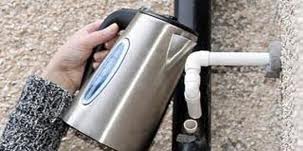Frozen Condensates
The Big Freeze
Modern condensing boilers produce a waste by-product called condensate, which is really just mildly acidic water. We need to safely get rid of this water into a drain. Many installers tend to route the waste pipe straight out the wall, and then run into an external drain. This was the easiest and most direct method. But, the winters we experienced in 2009 and 2010 in the UK meant that a lot more thought had to be put into the installation of condensate pipes.
Why do condensates freeze?
The majority is down to poor installation. Pipes with too shallow a fall, where waste water was laying in pipes and freezing, and those who ignored installation instructions and used undersized pipe outside, were left with a massive problem. Some pipes were installed along north facing or shaded walls. These areas are particularly susceptible as the low winter sun never really radiates any heat to these areas. Some installers incorrectly ran condensate into rain water guttering, which in freezing weather can completely ice up. Customers were faced with broken boilers and no heating, and the risk of further frozen pipes inside the house.
However, it is fair to say that the majority of installers have stuck to the letter of the law when fitting condensate pipes. They have just been victim of the severe winters we had. Boiler manufacturers did not design or write their instructions for weather that was quite that severe.
With temperatures dropping to at least -25C in some areas, homes were waking up freezing and without hot water, as boilers were breaking down due to these pipes freezing up. These pipes actually form part of the boilers flue system, so if they are blocked with ice, the boiler cannot get rid of the fumes, so therefore shuts down for safety reasons. It is said that with the effect of windchill on pipes, condensate can start to freeze at 2.8 degress centigrade. It doesn't have to be exactly freezing.
So what do we do if our condensate has frozen?
Pouring Warm Water over Condensate Pipe |
|---|
-
You should only attempt to thaw a condense pipe that is at ground level and which is easily accessible to you. Think about your safety! Under no circumstances should you attempt to thaw a condense pipe which is at height, without the assistance of a professionally trained engineer.
-
Pour hot water straight over the pipe, concentrating on where it comes out through the wall, and where it changes direction, such as an elbow joint. Also check where the end terminates if safe to do so. It may be sitting in a frozen drain or gulley.
- If you are careful, you can use a hairdryer to gently warm the pipe, however, as we are using electricity around water, please be vigilant and use an RCD circuit breaker on the plug as a minimum
- Gently agitate the pipe, where possible, such as shaking or tapping, and you may dislodge some of the ice inside the pipe
-
The condensate will evenually clear, and you may see or here a gush of water
-
Once it has cleared, try and reset your boiler, you may have to reset the boiler several times before it comes on again.
- Once it has thawed, please contact your local installer for a permanent solution to prevent problems re-ocurring
There are several remedial options available for condensate pipes where freezing up is likely. The top four being;
- Reroute into an internal drain, such as sink waste, internal stack
- Condensulate, which is an insulated pipe within a pipe that replaces your existing condensate pipe
- Trace Heated Wire-a heated wire strapped and insulated to existing condensate pipe ,activates at 5 degrees C and lower
- Weatherproof insulation fitted to existing condensate pipe
Please Remember, be if you are trying to thaw out your condensate, be very careful, it will be very slippy outside, be safe!

